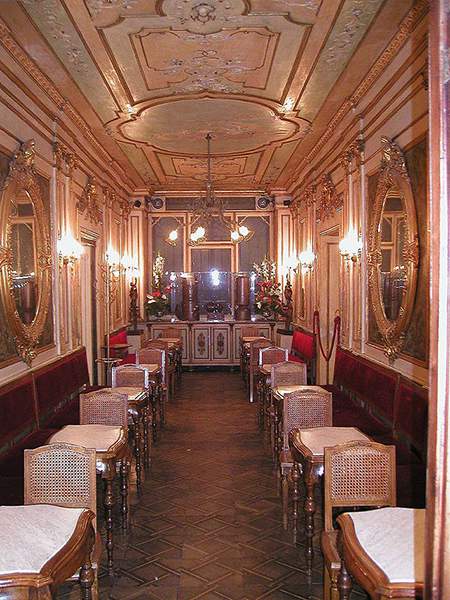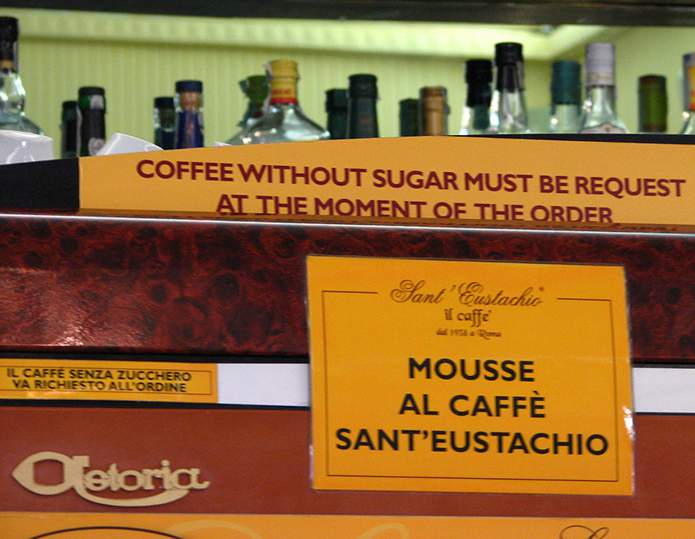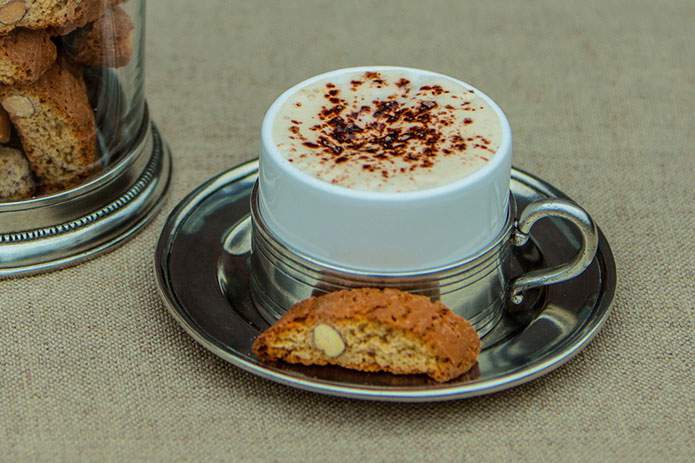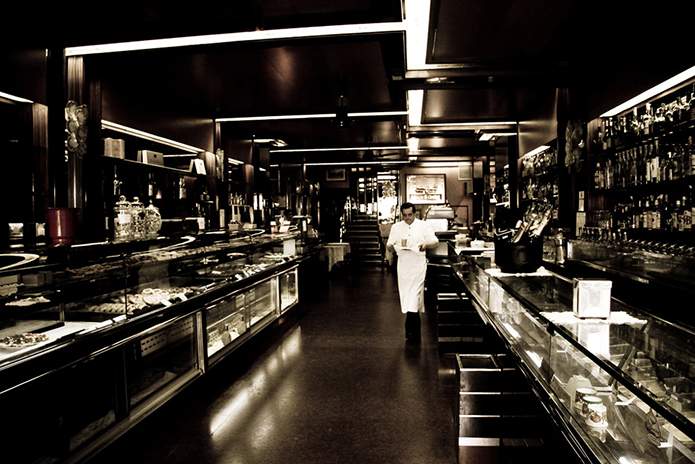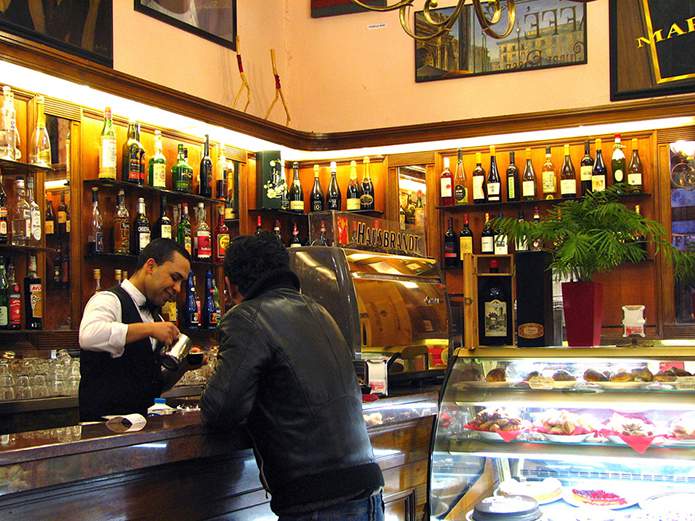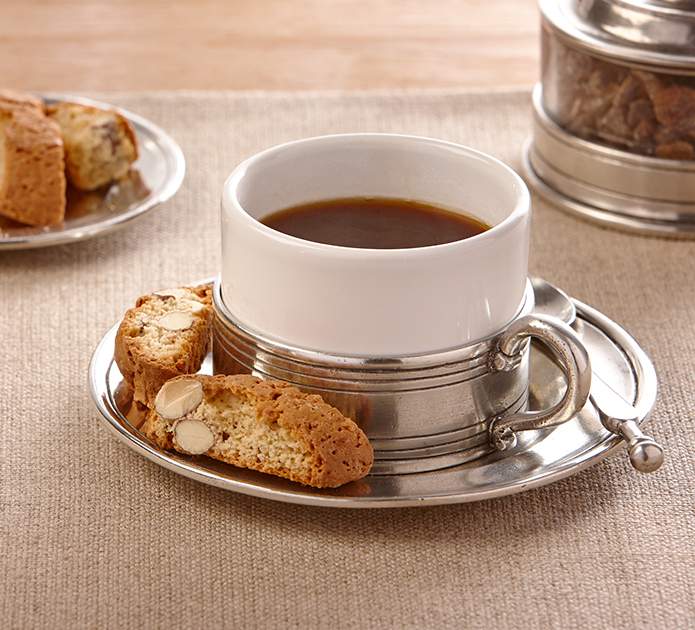
In Italy, coffee or ‘caffè’ drinking is taken very seriously. Coffee is not just a drink but a way of life. Ever since the coffee bean arrived in Italy via the ports of Venice from the Islamic East in the late 16th Century, the stimulating drink has been revered. Coffee was prohibitively expensive at first, but as coffee plantations were established within the European colonies, coffee prices fell and by the 18th Century coffee houses were common-place in all major Italian cities. In fact, some of these elegant establishments are still in existence in Venice, Turin and Rome, and queues regularly form to partake in ‘il caffè’ in these often tiny traditional coffee houses, for example the Caffè Florian on Piazza San Marco (Venice) is a popular tourist destination; opened in 1720, it is a strong contender for the title of the oldest in continuous operation.
Our Anglo-American long, milky, and often over-complicated, coffee concoctions taken whilst seated is completely alien to the average Italian. In order to experience and immerse oneself into the real Italian caffè culture, there are certain rules of etiquette that should be followed to avoid looking like the archetypal tourist. This article, like Italian coffee, gives you a short but full ‘taste’ of Italian caffè culture…so, as Ambrose would have said ‘When in Rome… or Turin… or Venice…’
Firstly, ask for ‘un caffè’, as the term ‘espresso’ is not used as simply a type of coffee, as it also means the process of ‘pressing’ the flavour from the coffee, at high speed. The espresso we are used to is just the default setting for Italian coffee anyway – short and strong, either from Arabica or a blend of Arabica and Robusta beans. You will be given a short, strong black shot accompanied by a small glass of water for cleansing the palate afterwards – it will almost definitely be stronger than you ever have at home.
You can order a double – ‘un caffè doppio’ if you like, but this is not usual in Italy. Italians do drink a lot of strong coffee, but only in small doses ‘un caffè solo’ is a single shot; if you want a longer drink, maybe ask for ‘un caffè lungo’, which contains more water. Italians drink their single shots first thing in the morning; on the way to work, often with biscotti, traditional Italian twice-baked biscuits, perfect for dunking; after lunch, as the caffeine will kick-start digestion, often necessary after a traditional long Italian four course lunch, preventing you from wanting to nap; small shots during the working day, for the same reasons; and finally, another after dinner before taking a stroll – ‘passeggiata’.
Those small doses of caffè are mainly unadulterated; there are just a few small variations, unlike the tome of 30 different coffee-based drinks, with ‘syrup this’ and ‘skinny that’ one is faced with in most Anglo-American coffee houses. The key alternatives are a strengthened or weakened espresso by adding less or more water; caffè ristretto or caffè lungo respectively. And there isn’t such a thing as de-caff coffee in Italy, even the caffè lungo is strong – so maybe order an ‘americano’ (a diluted weakened espresso) and admit that you are a tourist!
In the summer, iced or ‘freddo’ coffees are also popular, either as caffè or cappuccino, sometimes called ‘caffè shakerato’ – a shot of espresso shaken with ice, these chilled versions are often served sweet as standard – ask for it ‘amaro’ to avoid the sugar. In fact the Italians love to sweeten their coffee, be it hot or cold. There is an old saying – and apologies to any Italian speakers if this is not grammatically correct – “Quando il cucchiaio sta a piedi, c’e abbastanza zucchero nel caffè” meaning “When the spoon stands up straight [or upright], there’s enough sugar in your coffee”. Indeed, many Italians add so many spoonfuls of sugar to their tiny cups of espresso, that the content must have been thickened to almost a syrup!
Another version you may come across is caffè corretto; a ‘pick-me-up’ coffee served throughout the day, or after a dessert. Careful with this one as it is traditionally served with a drop (or two) of brandy, grappa, rum or sambuca – it is a drink favoured traditionally by builders! Hmmm…Where is that famous leaning tower..?
Milky variants such as cappuccino, caffè latte, latte macchiato (hot milk with a ‘stain’ of coffee – and consumed mainly by children or pregnant women) or caffè macchiato (espresso with a dash of milk), are allowed, yet ONLY in the morning – the latest, at a stretch, would be ‘elevenses’, as these milky versions are most often consumed as breakfast drinks; the high milk content perceived as a meal in itself, and certainly never after a meal.
Italians feel their digestion is compromised if milk touches a full stomach. Also, as a throwback to the not so far off days pre-refrigeration, milk would have been eschewed by the afternoon for fear that it had soured in the hot Italian sun. Holiday resorts are the exception to this rule, catering for the Anglo-American milky tastes. Oh, and definitely never just ask for a latte – you will most likely be given a glass of milk!
Depending where you find yourself, there have been just a few regional variations that have been approved by the ‘high council of caffè’ – the discerning Italian general public (coffee connoisseurs one and all!), those being; from Trentino a ‘cappuccino Viennese’, a frothy coffee with chocolate and cinnamon; ‘caffè alla nocciola’ from Naples, which is a frothy espresso with hazelnut cream; in the Marche region, a ‘caffè anisette’, an aniseed-flavoured espresso, an Arabic influenced ‘caffè d’u parrinu’ from Sicily, flavoured with cinnamon, cloves and cocoa; and a ‘marocchino’ from Alessandria, which is like an small cappuccino, served upside-down – cocoa powder is covered with frothed milk, then spiked with a shot of espresso. Or, if you are feeling generous or perhaps romantic; an increasingly rare Neapolitan tradition, a‘caffè sospeso’, which means a suspended coffee: one pays for two coffees but only drinking one, leaving the other for a stranger to enjoy – wow… caffè karma.
In Italy, a coffee-shop is known as a bar, and Italians often have a favoured bar, and these establishments are always run by a skilled a bartender known as a barista – ‘la mano’, or ‘the hand’, and again Italians often have a favourite. The barista, often trained for 2-3 years, is always extremely skilled at his/her art, and can deliver delicious real caffè at breakneck speed, often several at a time. There is an Italian phrase ‘la mano maestra’ – the master’s touch, and Italian baristas have it when it comes to making coffee. They have command of the right quantity of coffee, have a feeling for the right pressure when compacting the ground coffee and know the optimum brewing pressure. They can even conjure creamy milk froth to decorate coffees with what is known as ‘latte art’, miniature artworks in white and brown. A barista will match a face of a local to their drink of choice and set about preparing it for them – a little like a pub landlord knowing how so-and-so likes their pint, in a mug, tankard or straight glass; in fact, that is another subtle variation in Italian coffee drinking too; some prefer ‘caffè al vetro’ which is simply the same coffee, but in a glass rather than a ceramic cup – apparently there is a difference!
Whether, short, long, iced… all this caffè sorcery is reliant upon the barista operating a huge polished espresso machine, invented by, of course, an Italian – Luigi Bezzera. The extra-loud swishing, gurgling and ‘wwwhhhhhhaaaacccchhhhh’ noises that are emitted when the machine is at ‘full throttle’, along with the aroma of freshly ground coffee beans, the chink-chink of cups, saucers and spoons, together with the hum of fast-paced excitable Italian chatter is Pavlovian in the sense that you know a good coffee is imminent. So… go on, ask for one…
The bar etiquette is to call out your order confidently, even if the barista is not facing you (you will have to pay first if you are in a motorway service station – the barista will want to see your receipt – otherwise, as with any pleasant establishment, you are trusted to pay before you leave) and then when served your caffè, one should down it in 2 or 3 sips, pretty much there and then, whilst you stand at the bar – ‘al banco’. Coffee in Italian bars is consumed quickly, and on the move, so there is no time for the niceties of finding a comfy sofa, window stool… and it’s much cheaper drinking standing up compared to sitting down – ‘a tavolo’. The caffè can be consumed quickly as it is served at a lower temperature than we are used to in the British Isles; if you would rather a ‘boiling’ hot drink, you should request a ‘caffè bollente’, but you will find your fellow caffè drinkers, if locals, long gone before you are even able to sip yours!
Although it’s nice to understand the etiquette behind such a national institution and defining culture as coffee drinking in Italy, and how one should behave; ‘when in Rome…’, if, in fact, you are on holiday, what could be nicer than sitting outside of a Italian coffee-house in the sunshine, sipping a good coffee, gazing at the stunning vista, ornate architecture and watching the Italian world go by? So what if it has cost more for the pleasure? And so what if we look like tourists? We are tourists… just ‘drinking’ the whole ‘dolce vita’ moment of Italy and its imitable caffè culture. No doubt, on returning home you will want to try and recreate authentic Italianate coffee at home, for this, you do not need an all bells and whistles, whirring, steaming and gushing contraption that would take over half of your kitchen, but a stove-top aluminium percolator, a ‘macchinetta’, is essential, invented by, yet again, of course, an Italian, Alfonso Bialetti, in the 1930s. Every Italian home has one; enabling rich creamy espressos each and every time with minimum fuss.
As well as this, you need a little cup to hold the modest portion; it would be lost in a large mug. However, not just any old small vessel will do. Authentic Italian espresso cups, can be ornate in terms of the saucer and handle, yet the actual cup itself needs to be plain ceramic, most often white, to accentuate the richness in colour of the coffee, with a thickened bottom, to maintain the heat of the coffee; elliptical in shape in order to allow the oils and fibres of the blend to emerge without bubbles and have a thinnish rim to allow a refined sensation when sipping. These purposeful little vessels are aesthetic to behold as well as being practical, sipping from an espresso cup at home may even transport you, in spirit if not in body, back to Italy, the cultural home of ‘il caffè’.






